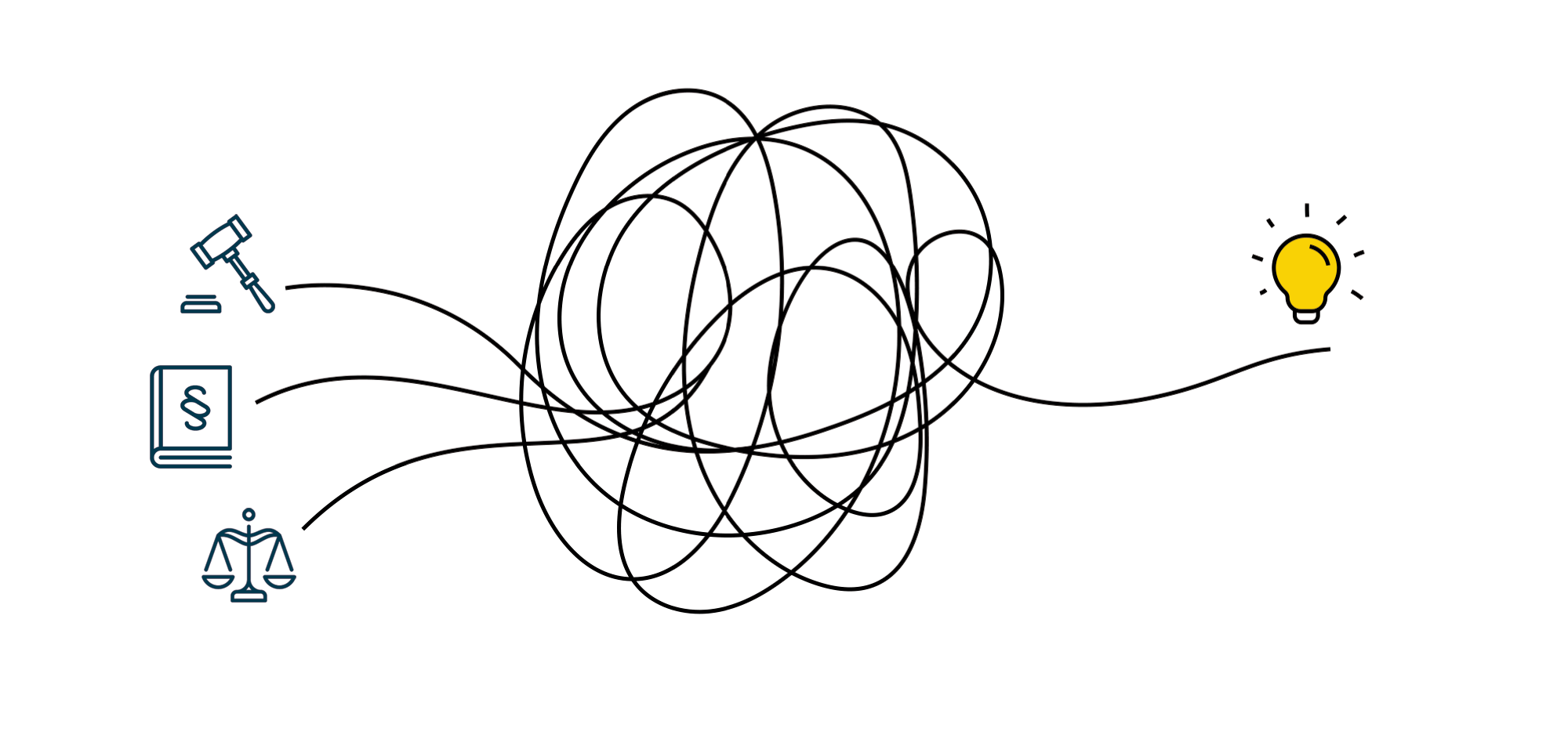The practice of design thinking in order to innovate and find creative solutions to problems is now well used by a wide range of industries – from marketing and business to engineering and the sciences. It is not often attributed to the legal industry, which people – particularly those who do not work in law – often consider staid and traditional. However, this could not be farther from the case.
Legal design thinking is a methodology that helps lawyers, firms, and even clients create new and effective ways of delivering legal services. Design thinking offers legal professionals a method to uncover solutions that are desirable, technologically feasible, and economically viable for the client (as opposed to the lawyer or legal system), and to prototype, test, and get feedback on those solutions in order to determine whether they meet the clients’ needs or need to be re-adapted.
Jeff Ward of Duke University School of Law characterizes design thinking for law as a process of experiencing knowledge and exploring the human mind’s playground of ideas. According to Professor Ward, design thinking “helps us to change the law for the better” in four primary ways, by: 1) asking participants to take on a beginner’s mindset, 2) looking beyond the borders of the “law” as it is traditionally defined, 3) stripping away the often-paralyzing fear of making mistakes, and 4) teaching creativity and prototyping as core skill sets. Defining legal work as an explorative process departs from many traditional models of legal problem-solving, which can tend to be rigid, myopically focused on precedent, and driven by antagonism and fear.
The benefits are numerous. In addition to placing the legal service user at the center of the solution, it also promotes collaboration and co-creation principles. The legal field is traditionally quite siloed but when design thinking is introduced, there arises multidisciplinary collaboration among lawyers within the firm, between lawyers and clients, and even between lawyers and non-legal professionals such as designers, marketing managers, engineers, data analysts, human resources, and IT staff. This cross-pollination within a firm proves quite powerful when it comes time to provide a consistent service.
The concept of design thinking has been around for more than fifty years, but it gained general public fanfare with the publication of IDEO CEO Tim Brown’s 2008 article Harvard Business Review. In this article, which was titled simply “Design Thinking,” Brown defined the concept as a discipline that “uses the designer’s sensibility and methods to match people’s needs with what is technologically feasible and what a viable business strategy can convert into customer value and market opportunity.” As designer Jon Kolko later explained, also in Harvard Business Review, organizations that “get” design “use emotional language (words that concern desires, aspirations, engagement, and experience) to describe products and users. Team members discuss the emotional resonance of a value proposition as much as they discuss utility and product requirements.”
Legal design thinking is not a one-day approach.
The methodology is not complex, but it requires discipline and creativity. The project-solving approach includes five stages: empathizing, defining, ideating, prototyping, and testing. Lawyers can start the process by empathizing with the user of the legal service – either a client or even the same lawyer, in case of internal projects or process improvements – by gaining insights into how they behave, feel, and think, and asking why they demonstrate certain behaviors, feelings, and thoughts. Once the lawyer has walked in the user’s shoes, so to speak, they are more able to identify a particular problem or opportunity that can serve to motivate the search for solutions. This is called briefing definition. When the problem has accurately been defined, the next step is to generate a wide range of ideas for these possible solutions, the most promising of which will be developed, prototyped and tested.
It’s important to note that legal design thinking is not a one-day approach. It is a non-linear and ongoing process that requires lawyers to constantly think of ways to improve the prototype, even after implementation. The need to continually observe, evaluate, reflect, innovate, and create in order to improve existing products and solutions has been defined by IBM as the loop of design thinking.
Law firms are now embracing design thinking to re-design the delivery of legal services and also enhance their value proposition to clients. For example, in 2017, the Chicago-based firm Baker McKenzie launched Whitespace Legal Collab to encourage creative problem solving through multidisciplinary collaboration between the firm’s attorneys and leaders in business, government, academia, and not-for-profits. According to the late Paul Rawlinson, former global chair of Baker McKenzie, the initiative was part of the firm’s wider effort to “cultivate a new type of thinking when helping our clients develop solutions to complex challenges.” Many of the collaborations center on innovations related to data privacy, smart cities, and other data-related – the aim being, as Pavel Abdur-Rahman of IBM Canada detailed, “to harness game-changing technologies including artificial intelligence, blockchain and quantum computing, innovators need to champion methods from experience-led design to multidisciplinary problem-solving.”
In order to get legal design thinking to work, lawyers must be willing to ignore their own assumptions and presuppositions in order to better understand their clients and colleagues.
The international law firm Seyfarth Shaw applied design thinking to address the question of whether quality legal services could be provided for a fixed fee. The result, which came after interviewing clients and lawyers and with unprecedented access to firm data, was the business model and prototype of a high-volume litigation solution, that includes an up-front collaborative approach, bespoke playbook for clients that maps out their specific interests, technology-based task management, and an intense focus on quality assurance. Through the process and new model, the lawyer-client interaction evolved from being merely a transactional one to an ongoing relationship and journey.
Design thinking also helps law firms improve internal processes. For example, when the multinational firm Hogan Lovells discovered that their performance reviews lacked substance and guidance for improvement, the firm collaborated with IDEO to redesign the process. By applying the principles of design thinking, they created individual note cards with specific questions for each associate to facilitate 10-minute conversations between associates and their supervisors, with targeted questions that kept the feedback sessions both focused and informal.
While design thinking in general has become relatively well known and practiced, it is not yet a consistent problem-solving approach to law, despite the above examples of successful legal design thinking. The reason for this is that the legal field does not (yet) have a culture that encourages and supports people-centric processes. Design thinking is a set of processes, yes, but above all, it is a mindset – one with strong emphasis on brainstorming, collaboration, prototyping, and developing solutions with the end-user in mind. This does not fit with the vertical, hierarchic, and rigid organizations of many law firms. And thus, in order to get legal design thinking to work, lawyers must be willing to ignore their own assumptions and presuppositions in order to better understand their clients and colleagues. The lawyers cannot do this work alone, such innovation must be supported by their firm and the legal system at large. We must consider the very essence of legal service – to look at it with fresh eyes and empathize, define, ideate, prototype, and test. And then do it again.
© IE Insights.






